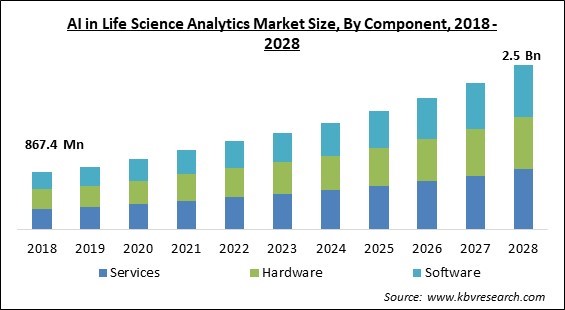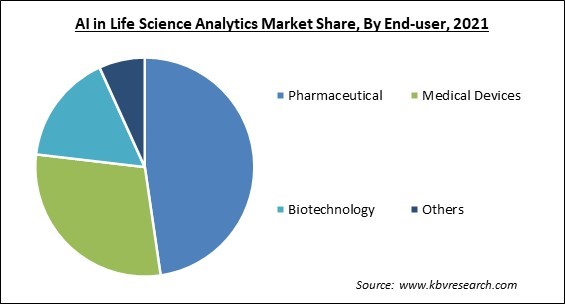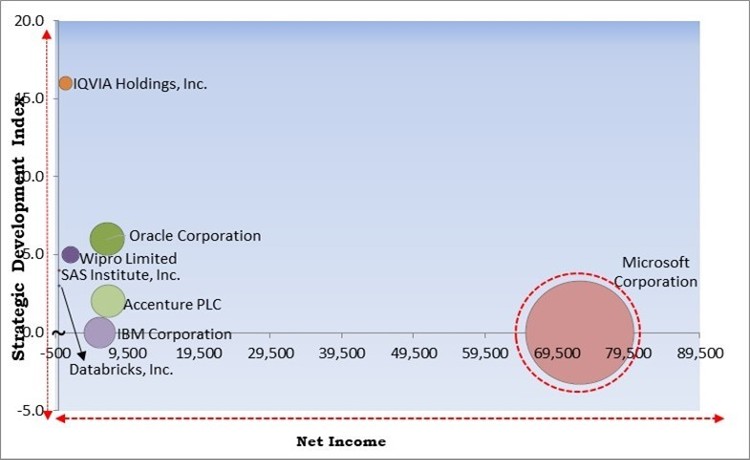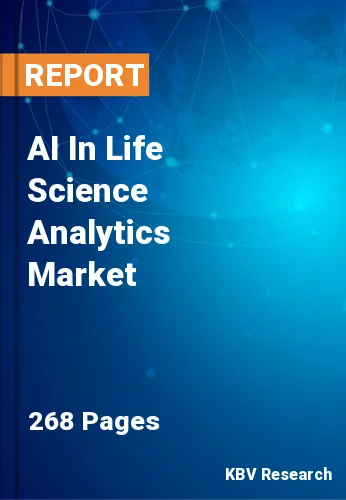The Global AI In Life Science Analytics Market size is expected to reach $2.5 billion by 2028, rising at a market growth of 10.9% CAGR during the forecast period.
The term artificial intelligence (AI) refers to a heavily data-driven technology. It is frequently used in the R&D departments of the life sciences sector to provide insightful data from fragmented sources. Though the use of AI technologies and tools is still in its early phases in the life sciences sector, yet it is facilitating companies to develop strategic technological skills for establishing a competitive edge.

Since it can deliver data quickly, precisely, and reliably, AI is gaining acceptance in the analytics field. Because of this, businesses are becoming keener to invest in incorporating AI algorithms into analytical solutions. The accelerating development of new technologies, such as artificial intelligence, and their widespread use across a variety of industries have increased demand for AI in the life sciences sector.
In addition, the application of AI in life sciences is also growing as there is a rising need to reduce costs and improve operational efficiencies in drug discovery and clinical trials. The rapid development of data-based AI, technological advancements in deep learning, and the growing requirement to achieve autonomy in robotics has propelled the implementation of AI in analytics.
This adoption is mainly driven by the inefficiency of the drug discovery process as a result of variables such as high costs of research and development, low success rates in clinical trials, and rising attention to rare diseases. The ability of machine learning technology to improve candidate recruitment processes, data storage, and data analytics is expected to drive market expansion.
The extensive help of AI in keeping track of the results of numerous clinical trials on an expanded scale further helped in creating more demand for AI and similar technologies. Furthermore, the development of technologies like electronic data capture (EDC) systems during the pandemic enabled document management monitoring and remote electronic signatures and further accelerated the trial processes. As a result, this immensely helped many pharmaceutical companies in developing efficient drug contenders rapidly. Therefore, the COVID-19 pandemic positively impacted the AI in life science analytics market.
AI technology has greatly influenced the personalized medicine and precision medicine development sectors. Unlike the previous methods of predictive modeling and mechanistic assumptions, AI solutions logically develop optimal drug combinations. These drug combinations are developed from genuine and successful experimental proofs by efficient analysis of modest datasets that are specific to the disease being assessed. Hence, by extending the reach of AI and ML in the development of personalized drugs and precision medicines, AI in life science analytics market is bound to grow.
Many pharmaceutical and biopharmaceutical companies have increased their investments in artificial intelligence systems as these extensively help in improving the identification of disease targets, designing of medication from the first step, toxicity, potency predictions, and chemical screening. In addition, deep learning enabled by AI is well suited for drug development because of its ability to extract essential features from unprocessed data, regardless of the dataset size. . This has further helped the adoption of AI and thus boosts the expansion of AI in life science analytics market.
The rising number of database sharing among research institutions, software companies, and clinical research organizations (CROs) presents a high risk of data leaks of confidential status. Frequent access to information may also result in the leakage of sensitive patient information to unofficial individuals. Since the majority of data is being maintained electronically, the application of analytics solutions and privacy policies compliance laws pose a significant challenge for biopharmaceutical and pharmaceutical companies. As a result, the R&D of drug development may get restricted by different governmental regulation shifts.
On the basis of end-user, the AI in life science analytics market is fragmented into medical devices, pharmaceutical, biotechnology, and others. The pharmaceutical segment acquired the highest revenue share in the AI in life science analytics market in 2021. The rising implementation of AI tools in drug discovery, clinical trials, and manufacturing are the primary factors that are advancing the growth of the segment. These tools significantly decrease the costs and cycle times while improving clinical outcomes.

Based on application, the AI In life science analytics market is segmented into research & development, sales & marketing support, supply chain analytics, and others. The supply chain analytics segment witnessed a considerable growth rate in the AI In life science analytics market in 2021. The supply chains of pharmaceutical and biopharmaceutical companies involve an intricate set of steps that are necessary for the production of drugs. Some prominent parts of the supply chain include raw materials’ sourcing and supply, manufacturing and distribution processes, and delivery of developed medications.
On the basis of deployment, the AI In life science analytics market is divided into on-premise and cloud. The cloud segment recorded the maximum revenue share in the AI In life science analytics market in 2021. Increased development of cloud services, penetration of the internet, and adoption of cloud-based technologies are the main factors propelling the growth of the segment. Implementation of cloud-based AI services is beneficial as they eliminate the requirement for dedicated data centers and hence lower the cost of investment.
Based on component, the AI In life science analytics market is categorized into software, hardware, and services. The hardware segment procured a remarkable growth rate in the AI In life science analytics market in 2021. In the field of biomedical engineering, AI-based systems are integrated to help in tasks like diagnoses and live image production for any minimally invasive surgeries. The further application of preconfigured hardware solutions aid in supporting crucial jobs of medical staff in medical practices, care facilities, and hospitals.
| Report Attribute | Details |
|---|---|
| Market size value in 2021 | USD 1.2 Billion |
| Market size forecast in 2028 | USD 2.5 Billion |
| Base Year | 2021 |
| Historical Period | 2018 to 2020 |
| Forecast Period | 2022 to 2028 |
| Revenue Growth Rate | CAGR of 10.9% from 2022 to 2028 |
| Number of Pages | 268 |
| Number of Tables | 453 |
| Report coverage | Market Trends, Revenue Estimation and Forecast, Segmentation Analysis, Regional and Country Breakdown, Competitive Landscape, Companies Strategic Developments, Company Profiling |
| Segments covered | Component, Deployment, Application, End-user, Region |
| Country scope | US, Canada, Mexico, Germany, UK, France, Russia, Spain, Italy, China, Japan, India, South Korea, Singapore, Malaysia, Brazil, Argentina, UAE, Saudi Arabia, South Africa, Nigeria |
| Growth Drivers |
|
| Restraints |
|
On the basis of region, the AI In life science analytics market is analyzed across North America, Europe, Asia Pacific, and LAMEA. The North America segment garnered the maximum revenue share in the AI In life science analytics market in 2021. The higher digital literacy, along with developments in the life science field in the region, has propelled the growth of the segment. In addition, the rising number of government initiatives and increasing collaborations between manufacturers and government bodies have further boosted the demand and integration of AI solutions. Many healthcare institutions in the region have also started adopting AI solutions to organize their workflows.
Free Valuable Insights: Global AI In Life Science Analytics Market size to reach USD 2.5 Billion by 2028

The major strategies followed by the market participants are Partnerships. Based on the Analysis presented in the Cardinal matrix; Microsoft Corporation is the major forerunner in the AI In Life Science Analytics Market. Companies such as Oracle Corporation, Accenture PLC, and IBM Corporation are some of the key innovators in AI In Life Science Analytics Market.
The market research report covers the analysis of key stake holders of the market. Key companies profiled in the report include Wipro Limited, Lexalytics, Inc., Databricks, Inc., SAS Institute, Inc., Sisense, Inc., IQVIA Holdings, Inc., IBM Corporation, Microsoft Corporation, Oracle Corporation, and Accenture PLC.
By End-user
By Application
By Deployment
By Component
By Geography
The global AI In Life Science Analytics Market size is expected to reach $2.5 billion by 2028.
Increasing Emphasis On Personalized Drugs And Precision Medicines are driving the market in coming years, however, Concerns Regarding The Safety And Privacy Of Crucial Information restraints the growth of the market.
Wipro Limited, Lexalytics, Inc., Databricks, Inc., SAS Institute, Inc., Sisense, Inc., IQVIA Holdings, Inc., IBM Corporation, Microsoft Corporation, Oracle Corporation, and Accenture PLC.
The expected CAGR of the AI In Life Science Analytics Market is 10.9% from 2022 to 2028.
The Sales & Marketing Support segment acquired maximum revenue share in the Global AI In Life Science Analytics Market by Application in 2021 thereby, achieving a market value of $905.6 million by 2028.
The North America market dominated the Global AI In Life Science Analytics Market by Region in 2021, and would continue to be a dominant market till 2028; thereby, achieving a market value of $1 billion by 2028.
Our team of dedicated experts can provide you with attractive expansion opportunities for your business.

